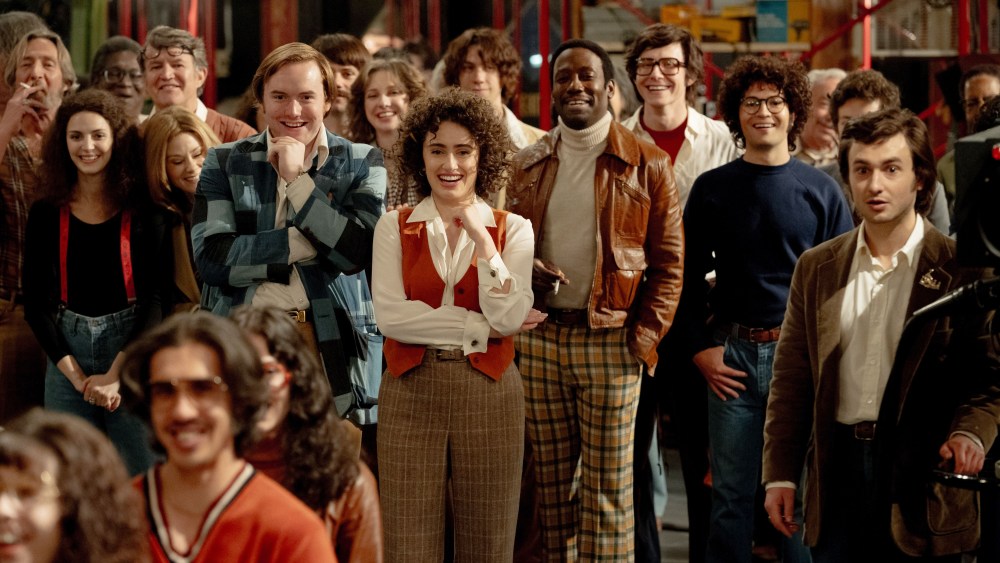How ‘Saturday Night,’ ‘Emilia Pérez’ Assembled Their Ensemble Casts
Konstantin Stanislavski taught us that “there are no small parts, only small actors.” Film and TV familiar face Dabbs Greer believed that “every character actor, in their own little sphere, is the lead.” Both would probably have been excited about this year’s Oscar race, where several best picture contenders high-light the power of an ensemble film: no matter where a talent ranks on the call sheet, everyone in the film has some choice scene time.
“I don’t care where they come from, but we had 80 speaking roles and they all have to match,” “Saturday Night” director Jason Reitman says of crossing oceans and comedy and drama verticals to find an eclectic mix of players to re-create the hour and a half leading up to the first-ever episode of NBC’s “Saturday Night Live.” “They all have to fit within the same world. We’re creating a ‘30 Rock’ that’s going to be one, 90-minute continuous scene where they’re all on screen at the same time and there’s no opportunity for someone to be an outlier.”
This meant casting actors against type, such as tapping Cory Michael Smith — known for playing Batman villain the Riddler in the Fox series “Gotham” — to play the notoriously cocky comedian Chevy Chase at the point in Chase’s career when Reitman says it feels “like you are touched by God and you’re about to launch into the stratosphere of comedy, and yet your ego needs to be humbled,” or having Lamorne Morris play Garrett Morris because the “Fargo” and “New Girl” actor understood the outsiderism that the elder talent experienced with being a person of color in a predominately white space. At the same time, the lesser-known Nicholas Podany was chosen to portray Billy Crystal because he was able to nail the Long Islander’s recognizable voice pattern.
Reitman and “Saturday Night” co-writer Gil Kenan wrote with the script on spec, treating it as a journalistic quest to interview as many of “SNL’s” original surviving cast and crew as possible. That Reitman, the son of late director Ivan Reitman, might know some of these people personally — a younger version of eventual “Ghostbusters” actor Dan Aykroyd is played by “Teen Wolf” actor Dylan O’Brien — was inconsequential. “It just becomes about, ‘How do you capture the energy of a moment?’” Reitman says.
Reitman also says the film was made through Sony versus NBC’s sister studio Universal simply because that’s where his production deal is, not because he and Kenan were avoiding any potential conflict with legendary “SNL” creator Lorne Michaels.
“I was always conscientious about talk-ing to all the original [cast and crew] and definitely getting Lorne’s blessing, but this was an independent film,” Reitman says, adding, “We made an early decision that we were not going to cast anyone from ‘Saturday Night Live’ [because] we never wanted it to seem like we were being meta or cute.”
Both Reitman and “September 5” director and co-writer Tim Fehlbaum were also fixated on their background performers. Both projects are about colleagues seeing in real time that they are creating history-making moments of 1970s television, and this meant that both needed background performers who would repeatedly be in shots.
For “September 5,” which is about the ABC Sports crew’s breaking news coverage of the 1972 Munich Olympic hostage massacre, Fehlbaum says that he scoured modern-day sports departments to get that workplace camaraderie and “real feeling of how these people interact and how they do certain things.”
However, he chose to use the actual chilling news footage of anchor Jim McKay telling the world that the hostages had not been freed, as originally reported, and that “they’re all gone.” Producers Philipp Trauer and Thomas Wöbke obtained the rights to that footage, and Fehlbaum also got the blessing of McKay’s son, CBS Sports chairman Sean McManus.
Fehlbaum did have name talent in some of the larger roles, such as Peter Sarsgaard as ABC Sports president Roone Arledge and John Magaro as the in-over-his-head young producer Geoffrey Mason. But he wanted these roles to seamlessly blend in with the rest of the cast.
“You want to follow the story and not the actors,” he says. “This is such an important topic, and we wanted to tell it in a very realistic way.”
“Emilia Pérez” casting director Carla Hool had the opposite problem. The film’s director and writer, French helmer Jacques Audiard, wanted name talent from Mexico because that’s the main setting for his Spanish-language musical drama about a cartel leader undergoing gender reassignment surgery. Hool, who specializes in casting Latin talent — her credits include the Netflix crime series “Narcos” and the Pixar animated film “Coco” — realized that those are a lot of boxes to check. She says eventually concessions were made to the script, switching Zoe Saldaña’s attorney Rita Moro Castro from Mexican to Dominican-born (Saldaña is part Dominican) and allowing for Selena Gomez’s Jessi Del Monte, the wife of the titular cartel head,
to be American.
Hool says that Karla Sofía Gascón, the Spanish actress who leads the cast as Emilia, is also not a trained singer. Both she and Saldaña had to take singing lessons.
With “Sing Sing,” director Greg Kwedar and his co-writer Clint Bentley had an even more unique challenge: When do you cast noted professional actors to play Sing Sing Correctional Facility inmates who are in an acting class? And when do you cast some of those formerly incarcerated men?
Kwedar says he knew he wanted Colman Domingo to play the wrongfully incarcerated John “Divine G” Whitfield and that deal was in place before the Broadway and film veteran’s benchmark year with his Oscar nomination for “Rustin.” They wanted “The Sound of Metal” Oscar nominee Paul Raci to play acting coach Brent Buell.
But Kwedar says he and Bentley were also cautious about going too big on casting because “you cast the wrong person in that role, and it’s the kind of role that comes in and tries to pull all the attention away from where the story is really happening.” In other words, “Sing Sing” would have felt very different if those roles were played by, say, Denzel Washington and Tom Hanks.
Domingo is also a theater teacher, which Kwedar thinks helped contribute to the authentic feel of the film. “With movies like this … that leadership kind of comes from the top, and he really helped lead the cast and help calibrate and help create that alchemy that we found, and that I helped direct, where … it was everyone entering the space as both a teacher and a student.”
The filmmakers did, however, have little doubt that the gregarious former inmate Clarence “Divine Eye” Maclin should play himself — and neither did Maclin. Kwedar says they asked Maclin how he’d feel about playing himself and that he seemed confused that they were even considering other prospects, saying, “Well, was there anyone else who was going to play me?”
A prison psychiatrist who was familiar with many of the formerly incarcerated actors was also on hand, something Kwedar says was especially necessary because their stages were at a recently decommissioned massive security prison that had once housed several of them. “Many [of these performers] hadn’t seen each other, some for over a decade,” Kwedar says, adding that for them to put back on the green prison scrubs and “to be back in a place that once governed every movement you made … but as a free man, and to be able to move freely, presented its own form of catharsis.”


